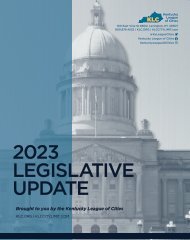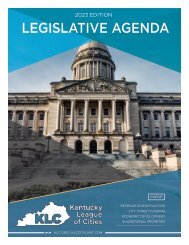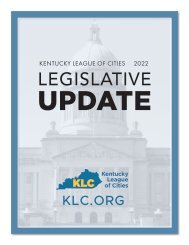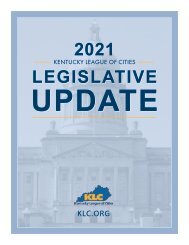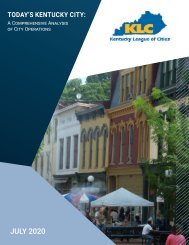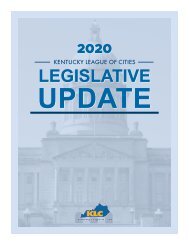KLC 2020 Legislative Agenda
Create successful ePaper yourself
Turn your PDF publications into a flip-book with our unique Google optimized e-Paper software.
KLC ADVOCATES FOR CITIES
WHAT IS THE KENTUCKY LEAGUE OF CITIES?
Established in 1927, the Kentucky League of Cities serves as the united voice of
cities in Kentucky. Committed to the principle of home rule, KLC believes local
decisions are best made at the local level. We are governed by a 62-member Board
of Directors that sets the Legislative Agenda for each session. KLC also has an
18-member Executive Board.
This year, the Board's top legislative priority for cities is ensuring separate
governance of the County Employees Retirement System (CERS) that is
free from political influence and solely focused on CERS to ensure it is not
unduly impacted by decisions made for the struggling Kentucky Employees
Retirement System (KERS). Top priorities for 2020 also include modernization of
the state's road funding formula, revenue flexibility and protection, and solutions
for the growing problem of blighted, deteriorated and vacant properties.
The goal of KLC and its members is enhancing the quality of life within our cities.
WHO DOES KLC SERVE?
The Kentucky League of Cities represents cities and the officials who serve them.
SERVICES PROVIDED BY KLC:
» Community Development
» Financial Services
» Municipal Law & Training
» Insurance & Loss Control
» Kentucky City Magazine
» KLC Conference & Expo
PAGE 1 OF 14
KLC LEGISLATIVE ADVOCACY EFFORTS:
» Local State and Federal Relations
» Annual Legislative Agenda for Cities
» Annual Legislative Update for Cities
Legislative Wrap-Ups for Cities
» Awards and Recognition of Legislators
Who Go Above & Beyond for Cities
» KLC City Limit News Website
» Weekly Legislative Bulletin
» Bill Drafting/Tracking During Session
» Research
» City Census
» Wage & Salary Survey/Report
» City Government Month
CITIES ARE BOOMING!
City populations are continuing to grow at a faster pace than unincorporated
areas, growing by 4.1 percent since 2010. In the past year alone, Kentucky cities
have added 8,000 people. In this decade, 80 percent of the state's population
increase has occurred within city limits. Today, 2.47 million people live in
Kentucky cities. Four out of five jobs in Kentucky are in cities and our city
governments spend more than $5.25 billion each year.
SERVICES PROVIDED BY CITIES:
Public Safety
Sidewalks & Street Lights
Clean Drinking Water
Sewer Systems & Waste Treatment
Economic Development
Safe Roads
Public Transportation & Bike Paths
Tourism and Recreation
Code Enforcement
Parks & Public Facilities
Utilities & Regulation
Youth & Senior Services
Trash & Recycling Collection
Historic Preservation
Job Training
Public Housing
PAGE 2 OF 14
KLC Legislative Agenda 2020
CERS REFORM/SEPARATION
30.00%
25.00%
20.00%
15.00%
Across the state, cities face the mounting cost of a
pension debt that now threatens the future availability of
services residents enjoy and expect. While the legislature
provided a much-needed phase-in of employer
contribution rates in the 2018 session, the pension bill
continues to grow. It is vital to the health of the County
Employees Retirement System (CERS), its employers and
members that the local pension system is put on a path
that ensures investment and management decisions
are based on what is best for CERS. That will require a
separate administration of CERS to ensure its funding
status grows and that the system remains viable for
future generations.
LEGISLATIVE PRIORITY: KLC will advocate for the
affordability of CERS and for separate governance
that is free from political influence and solely focused
on CERS assets and investments to ensure the local
pension system is not unduly affected by decisions
made for the struggling Kentucky Employees
Retirement System (KERS).
From investment strategies to the adoption of
assumption rates, CERS has felt the impact of decisions
that best benefit KERS. The Kentucky Retirement
Systems (KRS) Board of Trustees decided in 2018 to take
a less aggressive approach to investing and move from
equity funds to fixed-income investments.
CERS NONHAZARDOUS
INVESTMENT RETURNS
-Investment Returns
-30-Year Average
10.00%
i!..!.;--...... -,-:---t"r:-i
5.00%
0.00% .Jl-l+lU+Lllf.l-l+l'-'+--+'-'J.l""t'-'t'-'l"-1-t,,.+-"'t""",,.tw-+-+
-5.00%
-10.00%
-15.00%
-20.00%
Fiscal Year
Information KRS provided to the Public Pension
Oversight Board (PPOB) in June 2019 highlighted the
impact that decision has had on CERS. Investment
income earned by the CERS nonhazardous pension
system was one-quarter the amount earned in the same
period for the prior fiscal year.
KRS leadership argues its systems are too poorly funded
to take risks, but CERS is funded at 50.45 percent after
changes made to the mortality rate assumption in
April 2019. It is KERS that is funded at 13.66 percent and
is considered the worst-funded pension system in
America. KRS Executive Director David Eager has testified
that the Kentucky Teachers' Retirement System (KTRS)
sees much better investment returns than KRS because it
is "not in as bad of a shape as KERS" and can invest more
aggressively. However, KTRS is currently funded at 57.7
percent, and it uses drastically different assumption rates
than those adopted for CERS.
INVESTMENT RETURN ASSUMPTIONS FOR
STATE RETIREMENT PLANS NATIONWIDE
8.50%
8.00%
7.25%
7.50%
,...,
6.50% •
I+- CERS, KERS HZ: 6.25%
6.00%
5.50% t
KERS NH, SPRS: 5.25%
1.00% l ,, ___ _
5.00%
♦ Assumed Rate for Each Plan
Pension Plan
-National Median
------- .,..--
ti +ttttH+t -tttttl tttH +++t++Ht tttH
Source: National Association of State Retirement Administrators, 2019
In 2017, the KRS Board of Trustees moved the CERS
assumed rate of return to 6.25 percent. It remains the
second lowest rate in the nation outside of the KERS
nonhazardous pension plan and the Kentucky State
Police Retirement System (SPRS), which are overseen by
the same KRS Board of Trustees. Since that change was
adopted, KRS has reported a 10-year investment rate of
return for CERS of 8.9 percent and a 30-year return of
8.6 percent.
PAGE 3 OF 14
Separating the governance of CERS from KERS will help
ensure the local pension system is free from political
influence, regardless of future administrations. Additionally,
it will guard against CERS being lumped into decisions that
are made for the benefit of the state's struggling system.
The KRS Board of Trustees is comprised mostly of
gubernatorial appointees and representatives of KERS,
even though it does not account for most of the assets or
members in KRS. CERS is growing and now has 242,185
members compared to 134,477 in KERS. That makes CERS 64
percent of the membership and KERS 32 percent. While KERS
lost 10,710 employees from Fiscal Year 2009 to Fiscal Year
2018, CERS reported an increase in employment numbers.
percent of the KRS Investment Committee and 14
percent of its Actuarial Subcommittee. That unfair
representation is one of the reasons those advocating
for separate governance believe it is necessary to
ensure decisions are made in the best interest of the
local pension system, regardless of the plight of other
systems managed by KRS.
Because CERS is 64 percent of KRS membership, it
pays 64 percent of its administrative expenses. Those
are continuing to climb every year and are much
higher than other state pension systems that run
independently of KRS.
CERS is a local pension system, made up of city,
county and school board employees (excluding
teachers). It is important for the municipal employees
who keep our cities safe and desirable places to live.
They maintain our city halls, parks and streets. These
members provide police and fire protection and create
an environment that drives economic development.
They deserve a pension system that is also safe and
secure; one that is managed by people who put their
needs and interests first.
The local pension system holds a large chunk of the funds
KRS manages, $13.4 billion compared to $4.4 billion in KERS.
Despite being 73 percent of KRS assets compared to the 27
percent held by KERS and SPRS, it is the KERS funding crisis
that drives decisions and discussions at KRS. Testimony
given by Eager before a May 2019 PPOB meeting on why KRS
wanted to change the funding formula for all the systems
it manages did not include any data on how such a move
would impact CERS.
CERS representation on the KRS Board ofTrustees accounts
for just six of the 17 seats - 35 percent. It makes up 11
Follow us on twitter @freeCERSky
PAGE 4 OF 14
ROAD FUNDING FORMULA
KLC Legislative Agenda 2020
As cities continue to do more with less, the high cost
of maintaining vital infrastructure becomes more of a
struggle. The condition of our city roads and bridges
directly impacts the ability of a community to grow and
attract new business. While the population of Kentucky
cities has continued to expand, the funding formulas
of important transportation networks have remained
unchanged for 48 years. It is critical that we modernize
these formulas to ensure transportation needs are met
in Kentucky cities.
LEGISLATIVE PRIORITY: Cities support adopting
a new road funding formula to ensure city
governments receive a fairer proportion of new
state gas tax revenues for the construction and
maintenance of city streets.
From Kentucky's smallest cities to Louisville and
Lexington, neighborhoods need reliable roads to
bring jobs and improve quality of life. Cities are the
economic engines of Kentucky and are often the heart
of the state's infrastructure network. They must provide
consistent, safe services while also dealing with slow
financial growth.
While transportation needs have grown, the method
used to pay for our vital infrastructure has not been
amended in decades. Since 2013, 27 other states have
increased their motor fuel tax revenue, including
nearby Indiana and Tennessee. Kentucky has remained
flat. Cities have seen spending on streets and roads
climb 17 percent since 2010, while state and federal
support has dropped 21 percent.
Money collected in the motor fuels tax goes into the
state's Road Fund, of which 48.2 percent is shared
between cities and counties. How those assets are
divided is largely determined by a system established in
1948 that is known as the "formula of fifths." It is heavily
slanted toward rural counties and has not changed
in 70 years. The formula allocates one-fifth equally
PAGE 5 OF 14
>>>>>>>>>>>
to all counties, one-fifth based on rural population,
one-fifth by rural road miles and the remaining twofifths
by rural land area. The formula does not account
for the population boom of cities nor the high cost of
maintaining those heavily traveled roads. In fact, it can
penalize counties with rapid growth.
The last update to the system was instituted in 1972
when the legislature created the municipal road aid
program. It has not changed since that time, despite
a sizeable increase in the population of Kentucky's
cities. Municipalities are now responsible for more
than 10,000 miles of public streets. State and federal
road revenue provides only about one-fifth of the cost
of maintaining those thoroughfares.
A proposal to update the state's road funding formula
acknowledges the growth and demand on city streets
by equally dividing motor fuels income over $825
million, the total available for sharing in Kentucky in
Fiscal Year 2014. The amount above that threshold
will be split between the municipal and county road
aid programs at 13 percent each. This will help ensure
cities, which are often the center of commerce and
activity in a county, can pay to keep high-traffic areas
safe while also holding counties harmless.
Currently, 61 percent of yearly vehicle miles traveled
in Kentucky are on rural roads, yet counties receive 85
percent of road aid revenue. Urban roads account for
39 percent of vehicle miles traveled, but cities receive
only 15 percent of the state's road aid allocations. It is
time the state modernized the road funding formula to
equalize distribution and ensure cities have the money
to maintain roads and bridges that often need more
frequent repair and maintenance.
Some cities and/or counties have sales
tax authority (38 states)
No cities and/or counties have sales
tax authority (8 states)
No state or local sales tax (4 states)
The credit helps ensure taxes are not stacked on local businesses and workers. People who conduct business in a
city’s limits count on city services (police, fire, streets, etc.). Removing the crediting provision would ultimately result
in taxpayers paying for duplicate services. Eliminating the credit would result in millions of dollars of higher taxes for
more than a quarter million Kentuckians.
State government should not interfere with the collection of local revenue that provides vital community services.
Centralized collection of municipal funds would slow down the ability of city leaders to serve their citizens.
Additionally, it could create an environment where money designated for local projects ends up swept into state
coffers.
Mayors and other local elected officials are calling on state legislators to support the principles of home rule and
provide the tools cities need to keep the state on a path of progress and prosperity. Revenue diversification is a big
part of the equation. By allowing cities to pursue economic solutions that are specific to their community’s unique
challenges, Kentucky will be embracing modern funding solutions that help ensure the state continues to thrive.
PAGE 8 OF 14
ADDITIONAL PRIORITIES
Paramedic & EMT Training
Local governments are finding it more and more difficult to acquire qualified and
certified candidates for paramedics and emergency medical technicians (EMTs).
The current method used by the Kentucky Board of Emergency Medical Services
makes certification difficult to obtain, which can delay the hiring and training
process for cities in need of medical first responders.
LEGISLATIVE PRIORITY: Changes in the way the Kentucky Board of Emergency
Medical Services certifies paramedics and EMTs can make it easier for cities
to find qualified and certified candidates.
Elected City Official Career Retirement
In most Kentucky cities people serving in an elected position do so to serve their
community. It is a part-time job with minimal pay. Their full-time career may
involve the public sector, working for the local school or another employer that
participates in one of the state's retirement systems. For instance, the mayor
may be a school bus driver, or a city legislative body member may work in law
enforcement. Retiring from that career could require the city official to also
resign from his or her elected position, even if that was not the intent.
LEGISLATIVE PRIORITY: Cities are seeking legislation to permit an elected city official participating in the
County Employees Retirement System (CERS) who has a full-time job with an employer participating in
the Kentucky Retirement Systems to retire from that career without having to also resign from his or her
elected office.
Untrained Constables
Untrained constables pose a threat to the safety and security of cities. Several
incidents have already been documented of these elected officers abusing
their power and putting citizens in danger. In 2012, a committee created by
the Kentucky Justice and Public Safety Cabinet issued a report recommending
lawmakers review powers granted to constables under the Kentucky Constitution
to either eliminate or restrict the position or to grant local governments the right
to set limitations on constables.
LEGISLATIVE PRIORITY: KLC supports legislation to amend state law to eliminate the peace officer powers of
constables unless they are certified by the Kentucky Law Enforcement Council and approved by the county
fiscal court.
PAGE 11 OF 14
Legacy Police and Fire Pension Plans
' I
As pension costs continue to rise for local governments, it is important to
streamline expenses. When the County Employees Retirement System (CERS)
was established in 1958, it was designed to function as the pension system for
local government employees. While most cities are in CERS, some legacy pension
plans still linger.
LEGISLATIVE PRIORITY: KLC will advocate for a modification in membership
requirements for local boards of trustees of legacy pension plans and seek
legislation that allows beneficiaries to be paid an annuity to expedite
closure of these systems.
Annexation Filings with the Secretary of State
Many Kentucky cities are growing, adding to the population and city boundaries.
When a city annexes nearby property, it is required to file a new map with the
Secretary of State to ensure the state's database has the newest data.
LEGISLATIVE PRIORITY: Municipalities are seeking legislation that requires
annexation submissions to include an electronic map to expedite entry of the
new boundaries into the secretary's land database.
lnterlocal Cooperation Act
The Kentucky lnterlocal Cooperation Act gives local governments the ability
to work together to ensure constituents receive the best services at the most
advantageous cost.
LEGISLATIVE PRIORITY: Cities are looking to the legislature to update the
lnterlocal Cooperation Act to make it easier and more efficient for
governments to cooperate.
PAGE 12 OF 14
ADDITIONAL PRIORITIES
Planned-Unit/Homeowner Association Legislation
Neighborhood associations can often improve the quality of life in a city, providing
amenities and creating a sense of community. However, in some cases the
association cannot continue to afford the services it was designed to provide,
leading to concern about how neighborhood programs will be funded.
LEGISLATIVE PRIORITY: KLC will seek legislation to help municipalities address
problems created when homeowners' associations go defunct or planned-unit
documents do not adequately cover the maintenance of common areas.
Splash Parks/Pads
Splash parks are growing in popularity as they offer cities a less expensive way to
provide families more ways to enjoy the summer. These public areas have some
ambiguity under current Kentucky law.
LEGISLATIVE PRIORITY: Cities are advocating for legislation that determines
what laws and regulations apply to splash parks/pads compared to
swimming pools.
PAGE 13 OF 14
KLC LEGISLATIVE TEAM
KLC Advocacy Staff
n Jon Steiner
Steiner
J.D. J.D. Chaney
Chaney
Bryanna Bryanna Carroll
Carroll Bert Bert Bert May May
May Carl Carl Breeding
Rusty Rusty Cress
Cress
Executive Director/
Director/
Executive KLC KLC Deputy Director/
Deputy
Director Director of of of of of
Contract Lobbyist
Lobbyist Contract Contract Lobbyist
Lobbyist
Contract Contract Lobbyist
Lobbyist
CEO
CEO
Executive Executive CEODirector
Director
Governmental Affairs
Affairs
jsteiner@klc.org
jchaney@klc.org
bcarroll@klc.org
1-800-876-4552 klc.org
1-800-876-4552 klc.org
VISIT US AT KLCCITYLIMIT.COM!
TRACK LEGISLATIVE NEWS UPDATES
& MONITOR ISSUES DURING SESSION
PAGE 14 OF 14
KLC_
LEGISLATIVE
ADVOCACY
2020 EDITION II LEGISLATIVE AGENDA
CONTACT US
800-87 6-4552
104 Battle Aly
Frankfort, KY 40601
www.KLC.org
@KyLeagueCities
11 Kentucky League of Cities
K LCC I TYL IM IT.COM






